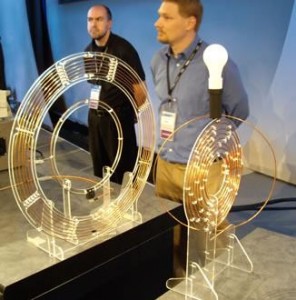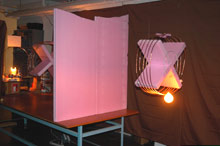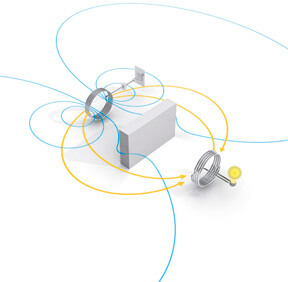The electronic revolution of the past century has been a tangled affair. Remember when phones were always wired into the wall? When the internet required one more cord from the back of your computer? Wireless is the future, which is all well and good for information transfer. But what about energy itself?

New research is bringing energy transfer into the wireless world. Soon, a central hub could be charging your batteries, laptop, televisions, electric cars, you name it… right through the air. You might never untangle a wire again. Cool, right?
Wireless energy is built on the principle of resonant coupling. The devices use copper coils that, if tuned to the same frequency, can resonate with one another. One coil is plugged into the wall, and creates an electromagnetic field; another coil nearby resonates with the first field, picking up some energy in the process to fuel your electronics. The magnetic field lets energy flow regardless of obstacles in the way, so the current can travel through walls. Currently, the type of radiation involved can only resonate within a few meters.
Over the past few years, a number of companies have been racing to put wireless energy on the market. Last week, researchers at Intel showcased a wirelessly charged iPod speaker. In 2007, researchers at MIT revealed a similar project that powered a lightbulb remotely. The physicist and project leader Marin Soljacic (winner of a MacArthur “genius grant” Fellowship) went on to found the start-up WiTricity, which is leading the pack in developing a commercially viable product.

The godfather of wireless energy transfer was Nikola Tesla, a brilliant and fascinating figure in the history of electrical engineering. In the late 1800’s, Tesla showed that electromagnetic energy could be transferred wirelessly. He also postulated that some day, all of our electronics would be able to harvest energy that is naturally present in space. That’s probably a little further down Intel’s pipeline.
But wireless energy transfer is far from perfect. The coils still need to be shrunk down so they can be easily integrated into everyday electronics (unless you want giant metal rings all over your house). The distance limitation is a major hurdle, with the fields limited to a few meters at this point. The energy transfer isn’t the most efficient process; MIT researchers transferred about 45% of the energy input, while Intel’s recent project showed an 80% transfer. That kind of energy loss poses a significant roadblock to the commercial viability of these technologies, as energy ain’t free.

Everyone is racing to work out these kinks and become the first company to put something on the market. Intel hasn’t announced any pipeline for their wireless tech; WiTricity’s business development guy claims that they’ll have something ready within 18 months. Regardless of who wins the race, Soljacic holds a patent on the research that started it all, which could let WiTricity play the old intellectual-property card. But what about Tesla’s grandkids?
Speaking of kids, wireless energy could help to make the household a safer place: no more wires for children to trip over, drop in the bathtub, or chew on. Okay, I don’t have kids, but I imagine they cause all sorts of trouble with wires.
Sci-fi depictions of the future always riff on how the technology will be fueled. I always loved the idea of the future being powered through the giant steam ducts hidden behind every wall in Terry Gilliam’s Brazil. The 80’s and 90’s made an insurmountable tangle of wires seem like a more likely scenario. But now, wirelessness prevails. And if Tesla was right, maybe we can even lose the wall outlet.



